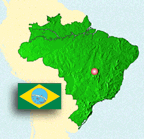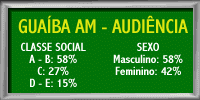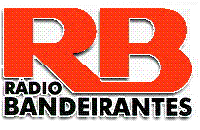From Sao Paulo south, the population is mainly of pure
European descent. At the same time that millions of Europeans
were immigrating to the US, in the late 19th and early 20th
centuries, millions were also immigrating to southern Brazil.
In the south, there are entire towns descended from Germans,
Italians, Poles, and Yugoslavs, among others. There are even a
half million Japanese in Parana and Sao Paulo states. As would
be expected for such a diverse ethnic quilt, Brazilian culture
varies from region to region. But regardless of which part of
the country one is in, Brazilians share a liking for good music
and having a good time.
Historically, shortwave has been necessary in Brazil because
of the country's size. In the less populated areas, shortwave
is the only way to broadcast to widely scattered villages,
ranches and settlements. To the most important stations in the
big cities, shortwave is the only way they can obtain truely
national coverage.
In his 1983 FRENDX article on DXing Brazil, Al Sizer noted
that the 1983 World Radio TV Handbook listed 191
frequencies in use in Brazil, with some stations using several
frequencies. By 1988, the figure had dropped to 151 frequencies
used by 111 stations (out of a total of 1114 stations). Many
stations in the more populated coastal states have dropped
shortwave frequencies in recent years.
However, that does not mean that shortwave is dying in Brazil.
As Brazil's western Amazon basin opens up to settlement, more
stations are starting up in that region. Many of them use
shortwave - it being the only viable way of communicating over
such vast distances. In the Amazon region, 35 of 57 stations use
shortwave, and there is plenty of room for expansion. For
example, Roraima territory - as big as Illinois - has only one
radio station! To our advantage, new Amazon stations will be
easier to hear than those of southern Brazil, since the Amazon is
the closest part of Brazil to North America.
Most Brazilian SWBC stations are found on the 90 and 60 meter
tropical bands. A few use 120 meters, or out-of-band frequencies
in the 3400-4200 range. If you hear a station in these bands
broadcasting in Portuguese, you almost certainly have Brazil.
The exceptions being during times of day when some African
stations can be heard in Portuguese. Note that most 60 MB
frequencies have two or more Brazilians on them, making hearing
an ID essential.
One thing unique about Brazil among tropical countries, is the
use of the international broadcast bands by the country's
domestic stations. True, most Brazilian shortwave stations use
the tropical bands. Yet, there are about 2-3 dozen stations
that can be found from 49 meters, all the way up to 16 meters.
Their low-powered transmitters - generally around 10 kilowatts -
make them hard to hear among the more powerful international
broadcast stations, yet given a clear channel they get out quite
well. For example, in the winter, when the 25 MB won't
propagate from Europe to North America during the evening,
usually several 25 MB Brazilians can be heard clearly. As many
Brazilian international band stations use frequencies in more
than one band, they can sometimes be IDed, so to speak, by
hearing them on two parallel frequencies at once.
When the Brazilian stations listed in Passport to World Band
Radio or the WRTH are compared to those logged in North
American DX club bulletins, it's easy to see that many stations
rarely if ever get reported. One might think that these stations
are inactive. Yet reports from DXers in South America show that
they really are on the air. Why aren't they heard in North
America then? Although there are a few Brazilians, especially in
the Amazon region, which can be heard nightly, many simply are
not "regular stations". Most can only be heard with better
reception conditions, unlike closer and regularly received
stations in Venezuela, Colombia, and Central America. When you
combine that with the facts that not many North American DXers
seriously go after the Brazilians, and that the best time to
hear Brazil is between 0700-0900 (when most of us would prefer
to be sleeping!), it's easy to see why Brazilian stations get
missed by North American DXers.
It is impossible to seriously DX Brazil without a minimal
familiarity with Portuguese pronounciation. Afterall, if you're
trying to hear an ID from Radiodifusora Jatai, you have to know
how Jatai is pronounced - it's not the same as in English.
Taking a class at a nearby university would be helpful, but
there's a far easier way. Just log your first Brazilian station
in English!
While you're listening to Radio Nacional's English broadcasts,
you'll learn more than just Portuguese pronounciation. Their
features will help you gain an understanding of Brazilian
culture, which will be useful in DXing the country. Also, Radio
Nacional plays a variety of Brazilian music - essential knowledge
for effectively DXing Brazil. It almost seems like someone down
there said, "DXers in North America seem to be ignoring us.
Let's teach them everything they need to know in order to DX our
radio stations." To top it off, Radio Nacional is a fun laid-
back station to listen to.
DXers complain that Brazilian stations do not seem to ID as
frequently as their Spanish-American counterparts. After
extensively monitoring Brazilian stations, I think that is true.
However, when Brazilians do ID, they more often used long
"canned" (pretaped) ID announcements, mentioning the station
name, location, call letters, and frequencies. So, if the
station name is drowned out in a burst of static, you may be
able to transcribe the location, AM frequency, or call letters,
so as to ID the station. Most Brazilian stations seem to play a
canned ID about once every half-hour, but rarely ID otherwise.
Brazil has a very well developed music industry, and, be it folk
music, pop, or rock, most music heard on Brazilian stations is
homegrown. In fact, Brazilian pop music is not only popular in
Brazil, but it frequently wins international competitions as
well. As mentioned above, the best way to become familiar with
Brazilian music is through the international broadcasts of Radio
Nacional do Brasilia.
Unfortunately for DXers, however, Brazilian stations never ID
during soccer games - not even at the top of the hour. Even if
you can pick out which teams are playing and where they're from,
that doesn't help since games are broadcast nationwide, just like
sporting events in North America. The only thing to do is enjoy
the game, or keep checking the frequency until the game's over.
Not all Brazilian stations are commerical. There are educational
and cultural stations too. Most stations with Cultura in their
names are owned by state or municipal governments, while most
with Educadora or Educacao are run by the Catholic church.
Additionally, the national government runs a chain of Radio
Nacional stations in the principal towns of the Amazon basin.
The programming on all of these is going to be somewhat different
than that of the commercial stations - no or few ads, more talk,
etc. They are roughly equivalent with Canada's CBC and NPR in
the US.
There are also a number of Brazilian stations named either Radio
Clube de . . . or Radio Sociedade . . .. These are among
Brazil's oldest stations. Most started out in the 1920s, when
only a very few wealthy Brazilians owned receivers. In many
cities, clubs were formed which supported nonprofit radio
stations through contributions from the members By the 1930s,
however, more Brazilians owned radio recievers, and commercial
radio stations came on the air. Gradually the radio clube and
radio sociedade stations switched to private commercial
ownership.
Actually there is some doubt among DXers if all Brazilian
stations really do relay these programs, Still, in the
Venezuelan DX bulletin The Radio News, Brazilian DXer
Samuel Cassio Martins recently confirmed that the law remains in
place. Samuel pointed out that during the programs, there are no
commericals, and the only station ID is at 2300 UTC, during the
brief break between the programs. Note that when Brazil is on
summertime (during the North American winter), both programs are
one hour earlier by UTC, than the times listed above.
The key to hearing stations in the 31 MB and above is picking a
time when the big European stations aren't there to drown them
out. Thirty-one meters is especially good around 0900-1000,
although there is QRM from Asia at that time. Twenty-five
meters, on the otherhand, is generally better on winter evenings.
Since few DXers seriously go after them, it's difficult to say
how well Brazilians verify. Indications, however, are that
Brazilians may be among the better verifiers in Latin America,
if only because they receive fewer reports, and therefore the
reports are more interesting to them. This assumes that you
send a good Portugues report, and include mint stamps or a SASE
(not IRCs!), and some goodies such as local postcards, pictures
of your shack or your family, etc.
When you receive a Brazilian QSL, be sure to do your part to help
the rest of us verify the station - send them a thank-you note.
Too many Latin American stations have stopped verifying because
they never received thank-yous, and thought that DXers don't
really appreciate QSLs. More on why thank-yous should be sent,
as well as appropriate Spanish and Portuguese sentences, can be
found in The Thank You Lab in Fine Tuning's DXer's
Guide To Latin America, 1989 edition. The booklet contains a
number of other features of interest to Latin American DXers as
well.
The biggest factor in becoming a pro, however, is experience. As
you spend time listening to and logging Brazilian stations,
you'll gradually learn more, and eventually you'll become a pro
without even knowing it!
GOOD LUCK!
The Radio News. Volume 1, No. 6.
Oliveira, Omar Souki. Brazil. In International Handbook of
Broadcasting Systems, edited by Philip T. Rosen. 1988.
Bonavita Federico, Maria Elvira. Historia da Comunicacao
Radio TV no Brasil.
This article is copyright 1989 by Don Moore.
This website is maintained by Don Moore,
Brazil Menu
Main Menu
What's New
Best of this Site
Radio History
Clandestine Radio
BRAZIL:
DON'T IGNORE IT - DX IT! By Don Moore

 Before we look at the radio side of things, though, let's
take a look at the country itself. Brazil is huge - the fifth
largest country in the world, and larger than the continental
USA. Its population of 140,000,000 is probably the the most
ethnically diverse to be found. In the nordeste, or
Northeastern states such as Ceara, Bahia, and Pernambuco, the
population is largely negro or mulatto (mixed black and white
ancestry). As one moves south, the descendents of African
slaves gradually give way to meztizos - people of mixed European
and Indian ancestry.
Before we look at the radio side of things, though, let's
take a look at the country itself. Brazil is huge - the fifth
largest country in the world, and larger than the continental
USA. Its population of 140,000,000 is probably the the most
ethnically diverse to be found. In the nordeste, or
Northeastern states such as Ceara, Bahia, and Pernambuco, the
population is largely negro or mulatto (mixed black and white
ancestry). As one moves south, the descendents of African
slaves gradually give way to meztizos - people of mixed European
and Indian ancestry.The Stations
There are few countries in the world with as many shortwave
stations as Brazil. The only countries that might have more are
Peru and Indonesia. However, a quick look through the WRTH will
show that Brazil's stations are generally more powerful. Few
Brazilian stations use less than one kilowatt, although many in
Peru and Indonesia do. Some Brazilian stations even mirror
their country's vast size. For example, Rede Globo, which owns
two shortwave Radio Globos, one each in Sao Paulo and Rio de
Janeiro, also operates the fourth largest TV network in the
world. Shortwave is a part of Brazilian culture. It even finds its
way into Brazilian literature, in the works of Brazil's most
beloved novelist, Jorge Amado. For example, in his 1975 novel
Tieta, when the prodigal daughter made rich in Sao Paulo returns
home to her impoverished family in northeastern Brazil, she
brings gifts for all - including a fancy shortwave receiver for
her brother-in-law. The entire family is amazed at the clarity
with which they can hear stations from the major cities of far-
off southern Brazil, and even Yugoslavia!
Shortwave is a part of Brazilian culture. It even finds its
way into Brazilian literature, in the works of Brazil's most
beloved novelist, Jorge Amado. For example, in his 1975 novel
Tieta, when the prodigal daughter made rich in Sao Paulo returns
home to her impoverished family in northeastern Brazil, she
brings gifts for all - including a fancy shortwave receiver for
her brother-in-law. The entire family is amazed at the clarity
with which they can hear stations from the major cities of far-
off southern Brazil, and even Yugoslavia!The Language Barrier
If there is anything that Brazilians want you to know about their
country, it is that they speak Portuguese, not Spanish.
Brazilians get very insulted by geographically ignorant
foreigners who think everybody in Latin America speaks Spanish.
Still, the two languages are very similar. If you know some
Spanish, you can probably pick out a few words of spoken
Portuguese. The biggest differance in pronounciation is that
Portuguese has some very nasalized vowels and dipthongs. Sounds contradictory, right? Not really. Unlike other DX-target
tropical band countries, Brazil has an easy to hear international
SWBC station, Radio Nacional do Brasilia, that broadcasts in
English. This station just happens to be one of the best tools a
DXer can have for DXing Brazil. The English broadcasts contain
extensive Brazilian news, and other features about the country.
Most importantly, though, all Brazilian states, towns, and
cities are given their Portuguese pronounciation. Listen to
the station several times with a good map of Brazil in front of
you. Note how place names such as Ceara, Cuiaba, Paraiba, and
Minas Gerais are pronounced. Keep a tape running, and play the
names back later for practice. Soon you'll not only know how
different Brazilian placenames sound, but you'll develop some
ideas of how written Portuguese corresponds to spoken sounds.
Sounds contradictory, right? Not really. Unlike other DX-target
tropical band countries, Brazil has an easy to hear international
SWBC station, Radio Nacional do Brasilia, that broadcasts in
English. This station just happens to be one of the best tools a
DXer can have for DXing Brazil. The English broadcasts contain
extensive Brazilian news, and other features about the country.
Most importantly, though, all Brazilian states, towns, and
cities are given their Portuguese pronounciation. Listen to
the station several times with a good map of Brazil in front of
you. Note how place names such as Ceara, Cuiaba, Paraiba, and
Minas Gerais are pronounced. Keep a tape running, and play the
names back later for practice. Soon you'll not only know how
different Brazilian placenames sound, but you'll develop some
ideas of how written Portuguese corresponds to spoken sounds. Programming
Most Brazilian SW stations are commercial, and simply simulcast
their station's AM frequency. The programming is not much
different from what you would hear in the US or Canada, except
the language is different. Most stations play music of one type
or another, with occasional time checks, advertisements,
community announcements, or station IDs thrown in. Phone-ins can
sometimes be heard, especially from the big city stations. News
broadcasts are usually on the hour, sometimes on the half-hour.
 Like commercial stations in North America, Brazilian staions also
broadcast live play-by-play sports. In Brazil, the most popular
sport - it's practically the national religion - is futbol, or
soccer. Soccer games are easy to recognize by the "spacy"
stadium audio sound and the mile-a-minute speed at which the
announcers speak. As the play heats up, the announcers talk
faster and faster and faster, until finally a point is scored
and, with the crowd cheering in the background, the announcer
screams "GOOOOOO (insert about a thousand 'O's here)
OOOOOOOOOOOAL!" Some announcers have actually been clocked
dragging the word out for over a minute. Even if you don't
understand a word (except GOO . . . OAL!), listening to a
Brazilian soccer game is a real taste of Brazilian culture. If
there is a list of "must hear at least once" things for SWLs and
DXers, Brazilian soccer games surely has to be on it.
Like commercial stations in North America, Brazilian staions also
broadcast live play-by-play sports. In Brazil, the most popular
sport - it's practically the national religion - is futbol, or
soccer. Soccer games are easy to recognize by the "spacy"
stadium audio sound and the mile-a-minute speed at which the
announcers speak. As the play heats up, the announcers talk
faster and faster and faster, until finally a point is scored
and, with the crowd cheering in the background, the announcer
screams "GOOOOOO (insert about a thousand 'O's here)
OOOOOOOOOOOAL!" Some announcers have actually been clocked
dragging the word out for over a minute. Even if you don't
understand a word (except GOO . . . OAL!), listening to a
Brazilian soccer game is a real taste of Brazilian culture. If
there is a list of "must hear at least once" things for SWLs and
DXers, Brazilian soccer games surely has to be on it. There are two Brazilian radio programs of special interest to the
DXer: A Voz do Brasil and Projecto Minerva. The first of
these came on the air in the 1930s, when the government of
Getulio Vargas needed an effective way to fight his political
opponents. Recognizing the power of radio, his government
started A Voz do Brasil. The hour-long program is still
around today, and by law all stations must relay it, Monday to
Friday, at 7pm (2200 UTC). A more recent addition to the
lineup, Projecto Minerva is produced by the Ministry of
Education. All stations must relay this program from 8:00-8:30
pm (2300-2330 UTC), Monday to Friday.
There are two Brazilian radio programs of special interest to the
DXer: A Voz do Brasil and Projecto Minerva. The first of
these came on the air in the 1930s, when the government of
Getulio Vargas needed an effective way to fight his political
opponents. Recognizing the power of radio, his government
started A Voz do Brasil. The hour-long program is still
around today, and by law all stations must relay it, Monday to
Friday, at 7pm (2200 UTC). A more recent addition to the
lineup, Projecto Minerva is produced by the Ministry of
Education. All stations must relay this program from 8:00-8:30
pm (2300-2330 UTC), Monday to Friday.When to Hear Brazil
Because Brazil is farther to the east, and hence in an earlier
time zone, than the rest of Latin America, Brazilians sign-off
and sign back on earlier than other Latin American stations.
Most Brazilians sign-off between 0200-0300 UTC, but they begin
signing on at 0700, and most are back on by 0800. Similarly,
Brazilians start to fade-in, and fade-out, earlier too. In
Eastern North America, those in the 49 MB and below begin to fade
in around 2200 UTC in the winter, and somewhat earlier in the
summer. In the winter they begin to fade out around 0900.
Remember, however, that Brazil is a huge country - there's a lot
of differance in sunrise and sunset times between Natal, on the
northeastern bulge, and Rio Branco in western Acre state. There
is even a time zone differance between eastern and western
Brazil. Overall, mornings are better than evenings for DXing
Brazil, assuming you can drag yourself out of bed! Reporting to the Brazilians
Generally  speaking, QSLing the Brazilians is just like QSLing the
rest of Latin America - except the reception reports must be in
Portuguese. Unless you happen to speak good Portuguese, the best
way to write reports is with a copy of Gerry Dexter's
Portuguese Language Lab. If you speak good Spanish, you
might try getting a Portuguese dictionary with verb conjugations
to make your own sentences. Although Portuguese grammar is more
complex than Spanish, there is enough similarity that you will be
understood by simply plugging Portuguese words into Spanish
grammar rules. I recommend this more for supplementing your
report, not writing the entire report.
speaking, QSLing the Brazilians is just like QSLing the
rest of Latin America - except the reception reports must be in
Portuguese. Unless you happen to speak good Portuguese, the best
way to write reports is with a copy of Gerry Dexter's
Portuguese Language Lab. If you speak good Spanish, you
might try getting a Portuguese dictionary with verb conjugations
to make your own sentences. Although Portuguese grammar is more
complex than Spanish, there is enough similarity that you will be
understood by simply plugging Portuguese words into Spanish
grammar rules. I recommend this more for supplementing your
report, not writing the entire report. Becoming a Pro
It's difficult to really become a pro at DXing any corner of the
world without putting effort into learning more about the
language and culture of that area. That holds true for Brazil.
If you want to know more of the language, and taking a class is
not possible, there are cassette courses available. You might
want to check your local library before you buy one, however.
While you're at the library, take a look at the books they have
on Brazil. A good feel for the various regions and cities can
be had by reading a travel guide. The South American
Handbook has an excellant section on Brazil. For a picture
of Brazil's move west to the Amazon basin, a recent issue of
National Geographic had an interesting article on
Rondonia. REFERENCES
Sizer, Al. Brazil. FRENDX, October, 1983. 
Association of North American Radio Clubs
DXer of the Year for 1995.